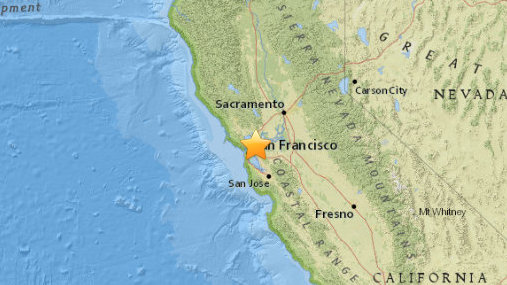Piedmont, CA…Just before 7am this morning a 4.0 on the Richter scale shaker started off Monday Morning in the Bay Area. BART was temporarily put on hold but everything is getting back to normal. The epicenter was 1 mile north of Piedmont, 2mi ENE of Emeryville, 3mi NE of Oakland, 3mi ZE of Berkeley and 65mi SW of Sacramento, CA. The tembler was on the Hayward fault. The quake was on the Hayward Fault. A bit more on the Hayward from the USGS is below…
From the USGS On The Hayward Fault
The Hayward Fault is a mostly right-lateral, strike-slip fault with approximately 5 mm/yr (1/5 inch/year) of creep. The 2003 Working Group for California Earthquake Probability, in agreement with previous working groups going back to 1990, assigned a slip rate on the Hayward Fault to be about 9 mm/yr (1/3 inch/year). This implies that approximately 4 mm/yr of motion is taken up in a stick-slip fashion, leading to the generation of earthquakes.
The Hayward Fault runs from San Pablo Bay in the north to Fremont in the south, passing through the cities of Berkeley, Oakland, Hayward, and Fremont. South of Fremont the fault branches into a complex set of surface faults that connect the Hayward Fault to the central part of the Calaveras Fault. The Hayward and Calaveras Faults may have a simpler connection at depths more than 5 km (3 miles), joining in the subsurface just south of the Calaveras Reservoir (site of the October 30, 2007 M5.4 Alum Rock earthquake). The Hayward Fault may be segmented into a northern and southern segment in the vicinity of Berkeley or Oakland.
The most recent major earthquake on the Hayward Fault occurred at 7:53 AM on 21 October 1868 with an estimated magnitude of 6.8. With an epicenter in the heart of the Bay Area, then having the largest population on the west coast with a total of 260,000 residents, this earthquake was one of the most destructive in California history, and remains the nation’s 12th most lethal earthquake. Property loss was extensive and 30 people were killed. Five deaths were reported in San Francisco, out of a population of 150,000, where the total property loss was estimated to be $350,000 (in 1868 dollars). This earthquake was known as the “great San Francisco earthquake” until the magnitude 7.9 shock on the San Andreas Fault on 18 April 1906.
Geologic studies at Tule Pond (Fremont) on the southern segment of the Hayward Fault have shown that the average interval between the past 5 earthquakes has been 140 ± 50 years. The average interval of the past 11 earthquakes on this segment of the fault is 170 ± 80 years.
The 2003 Working Group for California Earthquake Probability assigned a 27% probability that the Hayward-Rodgers Creek Fault system would produce a magnitude 6.7 or larger earthquake in the next 30 years.



